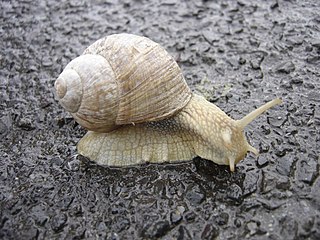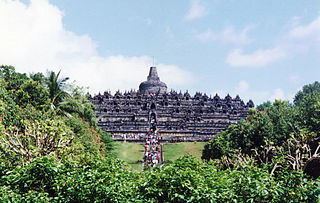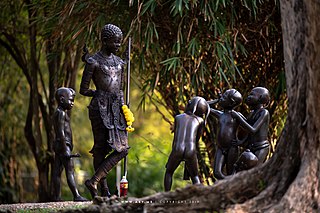
A snail is a shelled gastropod. The name is most often applied to land snails, terrestrial pulmonate gastropod molluscs. However, the common name snail is also used for most of the members of the molluscan class Gastropoda that have a coiled shell that is large enough for the animal to retract completely into. When the word "snail" is used in this most general sense, it includes not just land snails but also numerous species of sea snails and freshwater snails. Gastropods that naturally lack a shell, or have only an internal shell, are mostly called slugs, and land snails that have only a very small shell are often called semi-slugs.

Wayang, also known as wajang, is a traditional form of puppet theatre play originating from the Indonesian island of Java. Wayang refers to the entire dramatic show. Sometimes the leather puppet itself is referred to as wayang. Performances of wayang puppet theatre are accompanied by a gamelan orchestra in Java, and by gender wayang in Bali. The dramatic stories depict mythologies, such as episodes from the Hindu epics the Ramayana and the Mahabharata, as well as local adaptations of cultural legends. Traditionally, a wayang is played out in a ritualized midnight-to-dawn show by a dalang, an artist and spiritual leader; people watch the show from both sides of the screen.

Anjana, also known as Anjani and Anjali, is the mother of Hanuman, one of the protagonists of the Hindu epic, the Ramayana. She is said to have been a resident of Kishkindha in the text.

Topeng is a dramatic form of Indonesian dance in which one or more mask-wearing, ornately costumed performers interpret traditional narratives concerning fabled kings, heroes and myths, accompanied by gamelan or other traditional music instruments. Topeng dance is a typical Indonesian dance that can be found in various regions in Indonesia. Topeng dance has the main characteristic that the dancers use masks to cover their faces. The dance will usually be performed by one dancer or a group of dancers.

Folklore of Indonesia is known in Indonesian as dongeng, cerita rakyat or folklor, refer to any folklore found in Indonesia. Its origins are probably an oral culture, with a range of stories of heroes associated with wayang and other forms of theatre, transmitted outside of a written culture. Folklore in Indonesia are closely connected with mythology.

The Panji tales are a cycle of Javanese stories, centred around the legendary prince of the same name from East Java, Indonesia. Along with the Ramayana and Mahabharata, the tales are the basis of various poems and a genre of wayang known in East Java as wayang gedhog. Panji tales have been the inspiration of Indonesian traditional dances, most notably the topeng (mask) dances of Cirebon and Malang, as well as gambuh dance-drama in Bali. Especially in the environs of Kediri, the suggested homeland of the tales of Panji, local stories grew and were connected with the obscure legendary figure of Totok Kerot. Panji tales have spread from East Java (Indonesia) to be a fertile source for literature and drama throughout Indochina Peninsula and Malay World as well.

The Malay Gamelan is a style of music originated from Indonesia, performed in ethnic Malay-populated regions of Indonesia and Malaysia as well.

Smaradahana, also known as Smaradhana, Asmaradhana, Asmaradahana, Asmaradana, Asmarandhana or Asmarandana is an old Javanese poem (kakawin) written by Mpu Dharmaja as the eulogy for King Kameçvara of Kediri in early-12th century East Java. The story describes the disappearance of Kamajaya and Kamaratih from Svargaloka after being burnt by fire that burst from the third eye of Shiva. Their spirits fall upon the earth where, incarnated as human beings, their spirits seduce and inspire lovers' hearts.

Dewi Sri or Shridevi is the Javanese, Sundanese, and Balinese Hindu Goddess of rice and fertility, still widely worshiped on the islands of Java, Bali and Lombok, Indonesia. She is often associated or equated with the Hindu goddess Lakshmi, the shakti (consort) of Vishnu.

The mythology of Indonesia is very diverse, the Indonesian people consisting of hundreds of ethnic groups, each with their own myths and legends that explain the origin of their people, the tales of their ancestors and the demons or deities in their belief systems. The tendency to syncretize by overlying older traditions with newer foreign ideas has occurred. For example, the older ancestral mythology might be merged with foreign mythology, such as Hindu, Islam, or Christian biblical mythology.

Wawacan Sulanjana is a Sundanese manuscript containing Sundanese myths. The title means "The Tale of Sulanjana", derived from the name of the hero Sulanjana as the protector of rice plant against the attack of Sapi Gumarang cow, Kalabuat and Budug Basu boars symbolizing rice pestilence. The Wawacan Sulanjana contains Sundanese local wisdom through reverence of rice cultivation in its tradition.
Timun Mas or Timun Emas is a Javanese folktale telling the story of a brave girl that tries to escape and survive from an evil green giant that tried to catch and eat her.

Batara Guru is the name of a supreme god in Indonesian Hinduism. His name is derived from Sanskrit Bhattaraka which means “noble lord". He has been conceptualized in Southeast Asia as a kind spiritual teacher, the first of all Gurus in Indonesian Hindu texts, mirroring the guru Dakshinamurti aspect of Hindu god Shiva in the Indian subcontinent. However, Batara Guru has more aspects than the Indian Shiva, as the Indonesian Hindus blended their spirits and heroes with him. Batara Guru's wife in Southeast Asia is Shiva's consort Durga.
Totok Kerot, Thothok Kerot, or ThothokkêrotJavanese pronunciation:[ʈɔʈɔʔkərɔt] is a female character in folk tales, spread among people in the surrounding areas of Kediri. There are several different tales concerning her, but the common features are that she has ugly face, with appearance like butâ.
Dewi Lanjar is an Indonesian goddess of the sea, the opposite of Nyai Roro Kidul and the Queen of the Northern Sea, according to Javanese beliefs. She is a popular goddess in the city of Pekalongan, Central Java. Her name "Lanjar" means a woman who is divorced and have no children.
Ureongi gaksi is a Korean folktale about a poor man who breaks taboo and marries a maiden who comes out of a snail shell until he loses his snail bride when a magistrate kidnaps her. The tale features an inter-species marriage in which a snail transforms into a woman and becomes the bride of a male human. The tale also depicts the motif of a government official from the ruling class taking away a woman in a relationship with a lower-class male civilian.

Sang Thong, The Prince of the Golden Conch Shell or Anak Raj Gondang is a Southeast Asian folktale inspired from the Paññāsa Jātaka, a non-canonical collection of stories of the Buddha's past lives. In its Thai version, it tells the story of a prince who acquires a golden countenance, dons a disguise, marries a princess and saves the kingdom of his father-in-law.
The Snail Son is a character that appears in Japanese folktales, as a type of enchanted husband that becomes disenchanted from his animal form and becomes a handsome man. Some tales are related to the cycle of Animal as Bridegroom or The Search for the Lost Husband.

Lengger is a traditional Javanese dance originating from Banyumas, Central Java, Indonesia. This dance is played in pairs, between a man and a woman. Lengger dance is one of the sacred dances in Java.

Karambalangan is a type of personal armor from Java. It is a metal coating worn in front of the chest or breastplate.


















